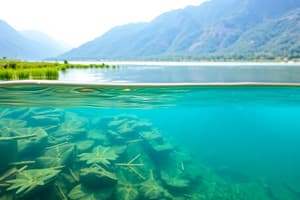Podcast
Questions and Answers
What are biogeochemical cycles?
What are biogeochemical cycles?
Overall chemical cycles through both the biological and geological world.
What are reservoirs in the biogeochemical cycles?
What are reservoirs in the biogeochemical cycles?
Parts of the cycle where the chemical is held in large quantities for long periods of time.
Which of the following are components of biogeochemical cycles?
Which of the following are components of biogeochemical cycles?
- Minerals
- Exchange Pools (correct)
- Atmospheric Layers
- Reservoirs (correct)
Which of the following cycles are part of biogeochemical cycles? (Select all that apply)
Which of the following cycles are part of biogeochemical cycles? (Select all that apply)
What is the water cycle also known as?
What is the water cycle also known as?
What is evaporation?
What is evaporation?
What is transpiration?
What is transpiration?
What does the carbon-oxygen cycle involve?
What does the carbon-oxygen cycle involve?
What process converts carbohydrates and oxygen into carbon dioxide, water, and energy?
What process converts carbohydrates and oxygen into carbon dioxide, water, and energy?
What is nitrogen fixation?
What is nitrogen fixation?
Which process in the nitrogen cycle converts ammonia to nitrate?
Which process in the nitrogen cycle converts ammonia to nitrate?
What is the phosphorus cycle's primary form?
What is the phosphorus cycle's primary form?
What is the result of weathering in the phosphorus cycle?
What is the result of weathering in the phosphorus cycle?
Flashcards are hidden until you start studying
Study Notes
Biogeochemical Cycles
- Refer to the interconnected chemical cycles within the biological and geological world.
- Each chemical has a unique cycle, but all share common components: Reservoirs and Exchange Pools.
- Reservoirs: Hold large quantities of a chemical for long periods (e.g., oceans, lakes).
- Exchange Pools: Hold chemicals for short periods (e.g., clouds, lungs).
Water Cycle (Hydrologic Cycle)
- Describes the movement of water through its different states (vapor, liquid, solid) across the ocean, atmosphere, groundwater, streams, etc.
- Powered by the sun's energy that drives evaporation.
Processes in the Water Cycle
- Evaporation: Liquid water transforms into gaseous water vapor, requiring significant heat.
- Transpiration: Biological process where plants release water vapor into the atmosphere through their leaves.
- Condensation: Water vapor changes from a gaseous state to a liquid, forming dew, fog, or clouds.
- Precipitation: Condensed water vapor falls back to Earth as rain, snow, sleet, or hail.
Carbon-Oxygen Cycle
- Involves the movement of carbon in various forms between the biosphere, atmosphere, oceans, and geosphere.
Processes in the Carbon-Oxygen Cycle
- Respiration: Organisms use carbohydrates and oxygen to produce carbon dioxide, water, and energy (O2 + Carbohydrates = CO2 + H2O + energy).
- Photosynthesis: Plants use carbon dioxide and water to produce oxygen and carbohydrates.
Nitrogen Cycle
- Involves the conversion of nitrogen gas into nitrogen compounds through the atmosphere, soil, and organisms.
Processes in the Nitrogen Cycle
- Nitrogen Fixation (Atmosphere): Lightning converts nitrogen gas into nitrates.
- Nitrogen Fixation (Soil): Rhizobium bacteria in legumes convert atmospheric nitrogen (N2) into ammonia, which plants can utilize.
- Nitrification: Nitrifying bacteria convert ammonia into nitrates.
- Assimilation: Plants and animals absorb nitrates and ammonia to build their tissues.
- Ammonification: Decomposers convert ammonia from dead animals and waste products into ammonia.
- Denitrification: Bacteria convert nitrates into gaseous nitrogen, returning it to the atmosphere.
Phosphorous Cycle
- The simplest biogeochemical cycle, describing phosphorus transformation and movement in soil, water, and living/dead organic material.
- Phosphorus exists primarily as phosphate.
Processes in the Phosphorous Cycle
- Weathering: Phosphorus in rocks weathers, releasing phosphate salts into the soil.
- Absorption by Plants: Plants absorb dissolved phosphate salts from the soil.
- Absorption by Animals: Animals obtain phosphorus by eating plants or other animals.
- Return to Ecosystem: Decomposers break down dead organisms, converting organic phosphorus back to inorganic forms, which are recycled to soil and water.
- Phosphorus eventually ends up in sediments and rocks, where it can be released again through weathering.
Studying That Suits You
Use AI to generate personalized quizzes and flashcards to suit your learning preferences.




